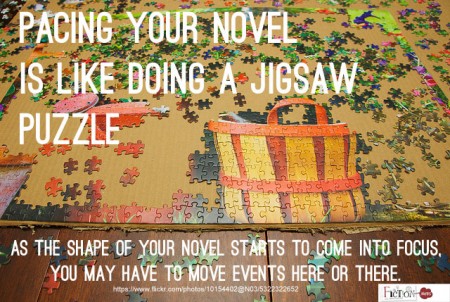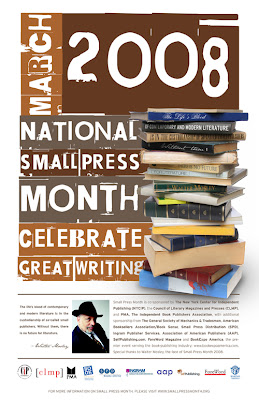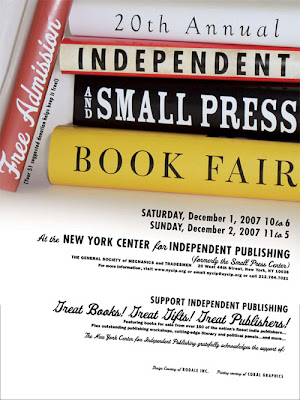new posts in all blogs
Viewing: Blog Posts Tagged with: overlook press, Most Recent at Top [Help]
Results 1 - 10 of 10
How to use this Page
You are viewing the most recent posts tagged with the words: overlook press in the JacketFlap blog reader. What is a tag? Think of a tag as a keyword or category label. Tags can both help you find posts on JacketFlap.com as well as provide an easy way for you to "remember" and classify posts for later recall. Try adding a tag yourself by clicking "Add a tag" below a post's header. Scroll down through the list of Recent Posts in the left column and click on a post title that sounds interesting. You can view all posts from a specific blog by clicking the Blog name in the right column, or you can click a 'More Posts from this Blog' link in any individual post.
Join Leslie Helakoski and Darcy Pattison in Honesdale PA for a spring workshop, April 23-26, 2015. Full info
here.
COMMENTS FROM THE 2014 WORKSHOP:
- "This conference was great! A perfect mix of learning and practicing our craft."�Peggy Campbell-Rush, 2014 attendee, Washington, NJ
- "Darcy and Leslie were extremely accessible for advice, critique and casual conversation."�Perri Hogan, 2014 attendee, Syracuse,NY
Tension on every page is the mantra for fiction writers. But what if your tension is spread unevenly throughout the story? That may be fine, because stories need a natural rhythm, an ebb and flow of action, thoughts, dialogue and reflection (inner dialogue). Some scenes may be crammed with small actions, while others pace steadily through the setting. Sometimes, though, I find that I’ve packed a scene with too many MAJOR revelations or actions, creating a top-heavy scene; that scene is usually matched by another scene that lacks enough tension.
My current WIP was in that position this week. One scene had two major confrontations. So, I decided to see if I could lift one Major Complication and put it elsewhere. The actual text, a revelation that someone was searching for the main character, took about 20 lines of text. Not so bad to move elsewhere, I thought.
But every part of a story is intertwined with every other part.

Timeline. First, there’s timeline issues. EventA happens before EventB. The RevelationEvent was originally the EventA, but I moved it to an EventC position, which meant that I had to go back and clean up the time line. There could be no mention of the RevelationEvent before Event B, of course. This is tedious work. You have to reread chapters thinking about what a reader should know at this point in the story, and make sure there’s no hint of the RevelationEvent that will spoil the surprise. Of course, I can hint at it; that’s called foreshadowing. Foreshadowing’s role, though, is to make the reader slap his/her forehead and say, “Duh! That’s exactly what should happen. Why didn’t I see it coming?” The reader should still be surprised, but the surprise is believable. Cleaning up the timeline is hard work, and if you slip up with even one half-sentence, you’ll be nailed on it by some alert reader.
Fitting it in. Unfortunately, you can’t just pick up the 20 lines and insert them where Event C occurs. Much of it may be salvaged verbatim, but much of it needs to be worded differently at the new place of the story. Keep the core of it, the meaning, but be willing to rewrite to make it seamless. The goal is to make it seem that the story was originally written this way.
As a revision exercise, I required my freshman composition students to write eight different openings for their essay. Often, the third or fifth or eighth opening was dynamite, and the writer chose to start his/her essay with it. Too often, though, it was stuck on the front and had no relationship to the rest of the story. I modified the assignment: students still wrote the eight openings. But then, in class to make sure they did it, they had to start writing the essay again from that starting point and keep writing for a timed period. I made sure the writing time was long enough to carry them into the body of the essay. That resulted in strong openings that were integrated into the whole essay. That’s what you want here, too.
One caution: keep a copy of the original version, because you may not like moving the event to a new place. In Scrivener, take a snapshot. In word processors, make a backup copy or a versioned copy; or use track changes to make the preliminary changes and then decide if you want to make them permanent.
The strategy of moving events is easy on the imagination. I don’t have to think up new events or complications; instead, I just need to use what I’ve already written in a stronger way.

By: frankramer,
on 9/10/2014
Blog:
(
Login to Add to MyJacketFlap)
JacketFlap tags:
Edgar Cayce,
dream journaling,
working with dreams,
Déjà vu,
On Dreams,
benefits of remembering dreams,
Dreamwork Methods,
dreamtime,
foreknowledge,
waking reality,
You only live twice,
dreams,
Uncategorized,
dream,
foreshadowing,
experience,
Add a tag

Déjà vu: How could I be here before?
, the experience of already having seen something or visited someplace, is a common experience that modern science cannot explain. For example, I might be traveling in a foreign country, visiting a famous place like the Great Wall of China for the first time. All of sudden I get the feeling I have been here and this place is familiar.
After nearly forty years of recording my dreams, and having so many dreams of being in strange places and meeting new people that become manifest in waking life, I am almost convinced déjà vu is an experience of remembering something or someplace previously seen in dreamtime, and the memory surfaces from the long-forgotten, or possibly never-remembered dream when waking reality mimics the earlier experience in dreamtime. I was first made aware of this dual reality when I was in college and had a dream just after my roommate became engaged.
Dream:
I dream of attending my college roommate’s wedding in a white church I didn’t recognize in waking life. The dream is vivid and clear in every detail, especially the completely white color of church exterior, the unusual reddish brown design inside the church and the fact that I am taken to the church in the groom’s parents’ white car, sitting in the right rear seat.
On waking I completely forgot about the dream because I wasn’t in the habit of recording my dreams at this stage of my life. When the day of the wedding arrived approximately six months later, and we were about to go to the church, I was told to ride in the groom’s parents’ white car. As I looked at the car, I suddenly I recalled the dream and remembered I had seen this before, been here and done this! I got goose bumps. Reality then played out according to my dream. I was told to sit in the right backseat, exactly where I was in the dream. On the way to the church I suspected the church would be all white on the outside and inside would have that unusual reddish brown design. And sure enough, it did.
Déjà vu suggests a Similar Dreamtime and Waking Reality
Edgar Cayce and others have stated that in dreamtime we get a foreshadowing of all the important events in our life before they become manifest in waking life. It is in dreamtime where we make choices that may eventually play out in waking time because dreamtime puts us into the future to prepare the way for us. That is one reason why Casey is quoted as saying “Dreams are today’s answers to tomorrow’s questions.” It’s like we are given a trial run. If we are dream-aware, we can make use of this test case scenario. If not, it’s as if we are programmed to follow through with the same decision in waking life as we made in dreamtime.
Living Twice in this Life
This concept of living our life twice, in dreamtime and waking time, is hinted at in popular culture with the James Bond theme song sung by Nancy Sinatra,
“You only live twice or so it seems
One life for yourself and one for your dreams.”
While some may interpret this to mean we live two different lives, one in our dreams (perhaps daydreams) and one in waking life, and these realities might not necessarily match in quality or enjoyment, my experience indicates that night dreams pretty well do match waking life—unless I consciously NOT make a decision I made in dreamtime because I didn’t like the outcome I saw in the dream. However, this type of decision-making requires knowing what was dreamed about and remembering it, perhaps many years after the dream! To me, this is what is meant by getting answers about the future from the dream. If you liked the outcome of your choice in dreamtime, go with it. If not, make another choice.
So the next time you experience déjà vu, consider that you may have passed this way before—in your dreams, and your dreams were preparing you for this experience.



By: Martha Alderson, M.A.,
on 8/5/2010
Blog:
Plot Whisperer for Writers and Readers
(
Login to Add to MyJacketFlap)
JacketFlap tags:
Plot,
Thematic Significance,
Cause and Effect,
foreshadowing,
scene transitions,
how to show a story,
see your story in your imagination,
guided imagery,
Add a tag
 I often do guided imagery work in plot workshops to relax writers before they begin plotting their stories (for most highly creative writers, the work I ask of them is very stressful and counter-intuitive and can involve quite a bit of resistance on the part of the writer. all writers are anxious about their writing in a group setting), and I use my voice. Guiding an imagery tour on a blog is awkward because you close your eyes. You also need the directions... You figure it out.
I often do guided imagery work in plot workshops to relax writers before they begin plotting their stories (for most highly creative writers, the work I ask of them is very stressful and counter-intuitive and can involve quite a bit of resistance on the part of the writer. all writers are anxious about their writing in a group setting), and I use my voice. Guiding an imagery tour on a blog is awkward because you close your eyes. You also need the directions... You figure it out.
Oh, and if, at anytime during the exercise, you are so moved to leap to your feet and write, by all means... do it.
Find an hour of undisturbed time (nice if you do this in bed before you arise in the morning or at night before falling asleep).
Make yourself comfortable sitting or lying down.
Close your eyes.
Take a deep breath.
Let the breath out slowly and mindfully (in other words, concentrate on the air of the breath itself as it passes through your nostrils and how it feels against your upper lip and...)
Arrange the first scene of your story in your mind.
Take another breath.
Let it out.
Settle into the scene. Wait for the fuzziness of the image of the character in the setting clear.
Take a breath.
See your protagonist move from the first scene to the next scene in your story.
Like a film reel, let each scene play out moment-by-moment to the end of the story. Instead of seeing the words of your story on the computer screen, see the actual action take place behind your eyelids with your imagination.
Benefits:
1. Transitions are often determined by character motivation. When the reader understands what motivates the character to transition between two scenes (locations, time periods), the story flows. In order to image your story, you move between scenes. Without the character motivation, the movement becomes episodic. Character motivation provides a sense of cause and effect, and the movement of the story flows. If the character motivation isn't in your scenes as written, it likely will pop up now. Watch for transitions and keep character motivation in mind to incorporate in your story.
2. Foreshadowing opportunities reveal themselves. You may have noticed in real life that nothing appears out of nowhere, out of the blue? Well, even if you haven't noticed that, in stories, one scene serves to foreshadow what comes next or later in the story. The first scene is preparatory, sets up a feeling of anticipation in the audience. Watch each scene to see what it foreshadows about the upcoming major turning points in the character emotional development plot and the dramatic action plot.
3. Thematic tie-ins hover over the story as you imagine it. Watch for them and take note.
 Recent post about Foreshadowing talks how every paragraph, sentence, word in the Beginning (1/4) introduces or foreshadows the character emotional development, dramatic action, thematic significance.
Recent post about Foreshadowing talks how every paragraph, sentence, word in the Beginning (1/4) introduces or foreshadows the character emotional development, dramatic action, thematic significance.
The opposite is also true.
Anything you introduce in the Beginning (1/4), the savvy reader knows on some level is important to the overall story.
Therefore, be careful about every word you use. If you use dark and ominous words in the Beginning, the reader expects the story overall will be dark and ominous. If you introduce a gun, the reader knows violence is coming, likely even death by gunshot. If you introduce sweetness and light, the reader expects the story to reflect the same.
Of course, you can switch things up later and turn the tables, so to speak.
Just make sure you know what you're doing and why.
Make your words count, every single one of them...
For more on Foreshadowing and the importance of the Beginning (1/4):
 One of my students, a sixth grade girl, is moving from southern California to Texas this summer. The class is currently taking a test on the first three parts of the Trojan War by Olivia Coolidge. I just walked by the girl's desk and her post-test silent reading book is titled Texas Disasters (pictured). Talk about foreshadowing!
One of my students, a sixth grade girl, is moving from southern California to Texas this summer. The class is currently taking a test on the first three parts of the Trojan War by Olivia Coolidge. I just walked by the girl's desk and her post-test silent reading book is titled Texas Disasters (pictured). Talk about foreshadowing!
Last night I talked to Mom on the phone. She told me about my long lost aunt who is married to a guy named Mouton. Mouton? First off, I've never heard the name. Well, there was a baseball player named Lyle Mouton who hit balls to the moon when he played for LSU, but that's pretty much it. My response to Mom was, "That's a perfect bully's name if I've ever heard of one."
Both of these instances remind me how many details of everyday life we, as writers, can bring to our stories and characters to make them real and multi-dimensional (try saying that five times in a row).
Poor girl. I hope she avoids disaster at her new school.
White pebbles help Hansel and Gretel find their way home. Breadcrumbs simply vanish.
Stories are shown in scene. Each scene leaves little pebbles to advance the plot on at least three levels:
Dramatic Action plot
Character Emotional Development plot
Thematic Significance plot (and more...)
A Few White Pebbles to lead the reader to the important parts of the story:
- Cause and Effect = because of what happens in one scene, the next scene arises. Cause and effect leads the reader from one scene to another. Cause and effect lessens confusion about motivation, which leads the reader deeper into the real time moment of the story.
- Authentic Details = generic details lull the reader to daydream rather than follow along with the story. Authentic details ground the reader in the world of the story unfolding moment by moment.
- Foreshadowing = Provide a few beats of foreshadowing so the reader does not just read right past an important scene. Example: A powerful secondary character triggers the Crisis. In the Beginning (1/4), she's introduced in conflict with her father. She wants to sing in Nashville. He wants her to get a swimming scholarship for college. Both of her strengths and the core conflict are alluded to in the first scene in which she appears. The second time the secondary character appears is practicing vocals with her band. The audience does not yet know the importance of this character in the overall story. The reader is still scrambling to get oriented in the story; determine who is who, what's going on. To help ensure that the reader does not just read right past the practice scene, toss out a few white pebbles to lead the audience. Scene of introduction contains dialog about what is coming: "we're practicing at the house after school today." The reader anticipates the later scene. When the scene comes, the reader pays attention.
- Exotic World = Show the scene as an exotic world that identifies the daughter as uniquely separate from her father.
Any white pebbles to share?

By:
Darcy Pattison,
on 12/11/2008
Blog:
Darcy Pattison's Revision Notes
(
Login to Add to MyJacketFlap)
JacketFlap tags:
openings,
writing techniques,
story plot,
write a novel,
agent,
query,
writing tips,
novel,
agents,
first chapter,
write,
foreshadowing,
opening lines,
Add a tag
The holidays and the end of the year are bringing out the generous nature of agents!
The 2nd Sort-of-Annual Stupendously Ultimate First Paragraph Challenge
- Deadline: 7pm. EST, Thursday, December 11, 2008.
- Who: Literary agent Nathan Bransford, Curtis Brown, San Francisco office
- What: Post the first paragraph of your WIP and compete for the prize of a partial critique, query critique or a 15 minute phone call.
- How: Skip over to Bransford’s website and post your paragraph in the comments.
- Warning: The competition is stiff. With 10 hours left, there were 1176 comments/paragraphs.
- Attention: This is a learning opportunity. Read through at least some of these paragraphs and see which you like and which you don’t. What grabs your attention? Check back when Bransford posts the winners and vote on the finalist. Do you agree with his choices or not? Why or why not?
For more on opening lines:
Take a Holiday Break from Queries and Submit a Chapter Instead
- Dates: December 15 to January 15
- Who: Firebrand Literary
- What: Firebrand agents want to read your first chapter and will forego the usual query. This is a big task for those agents and a great opportunity for writers of all kinds. For those of you who have never got a request for a partial (probably because your query was weak), this is your golden chance. Let your writing speak for itself.
- How: Go to the Query Holiday posting on Firebrand’s website.
For more on opening chapters:

 March is National Small Press Month, now in its 12th year, a nationwide promotion highlighting the valuable work produced by independent publishers. An annual celebration of the independent spirit of small publishers, Small Press Month is an effort to showcase the diverse, unique, and often most significant voices being published today. The Overlook Press, honored by the New York Center for Independent Publishing in December 2007, and recently profiled in Publishers Weekly, is a small press in its 37th year! Celebrate great writing this month with these new releases: The Wentworths by Katie Arnoldi; Song of the North by Jules Watson, Courting Shadows by Jem Poster, Funny Boys by Warren Adler, The Secret Adventures of Charlotte Bronte by Laura Joh Rowland, and The Better Angels by Charles McCarry.
March is National Small Press Month, now in its 12th year, a nationwide promotion highlighting the valuable work produced by independent publishers. An annual celebration of the independent spirit of small publishers, Small Press Month is an effort to showcase the diverse, unique, and often most significant voices being published today. The Overlook Press, honored by the New York Center for Independent Publishing in December 2007, and recently profiled in Publishers Weekly, is a small press in its 37th year! Celebrate great writing this month with these new releases: The Wentworths by Katie Arnoldi; Song of the North by Jules Watson, Courting Shadows by Jem Poster, Funny Boys by Warren Adler, The Secret Adventures of Charlotte Bronte by Laura Joh Rowland, and The Better Angels by Charles McCarry.
.JPG) The Bookseller reports "Peter Mayer is to be awarded with a lifetime achievement award at this year's London Book Fair, following in the steps of Lord Weidenfeld, Christopher MacLehose, John Lyons, and Lynette Owen. Mayer will pick up the fifth annual LBF/Trilogy Lifetime Achievement Award in International Publishing at the London Book Fair on Tuesday 15th April at a special reception in the Earls Court Conference Centre. The award, voted for by the London Book Fair's advisory board, was unanimously agreed after the merits of a shortlist of six international publishing figures were debated. This year's judges commented that Peter Mayer had made an outstanding lifelong contribution to the international publishing industry through his various roles including Penguin India. From 1978 to 1996 he was the chairman and c.e.o. of the Penguin Group, based in London and New York. Since 1996 he has held the position of president and publisher of The Overlook Press and since 2003 he has been the president and publisher of Duckworth Publishers in the UK. Simon Master, chair of the advisory board, said: "Peter Mayer has long been an inspirational figure in the publishing industry both in the UK and overseas. His dedication to British and international publishing has distinguished his career and makes him fully deserving of the London Book Fair/Trilogy Lifetime Achievement Award 2008."
The Bookseller reports "Peter Mayer is to be awarded with a lifetime achievement award at this year's London Book Fair, following in the steps of Lord Weidenfeld, Christopher MacLehose, John Lyons, and Lynette Owen. Mayer will pick up the fifth annual LBF/Trilogy Lifetime Achievement Award in International Publishing at the London Book Fair on Tuesday 15th April at a special reception in the Earls Court Conference Centre. The award, voted for by the London Book Fair's advisory board, was unanimously agreed after the merits of a shortlist of six international publishing figures were debated. This year's judges commented that Peter Mayer had made an outstanding lifelong contribution to the international publishing industry through his various roles including Penguin India. From 1978 to 1996 he was the chairman and c.e.o. of the Penguin Group, based in London and New York. Since 1996 he has held the position of president and publisher of The Overlook Press and since 2003 he has been the president and publisher of Duckworth Publishers in the UK. Simon Master, chair of the advisory board, said: "Peter Mayer has long been an inspirational figure in the publishing industry both in the UK and overseas. His dedication to British and international publishing has distinguished his career and makes him fully deserving of the London Book Fair/Trilogy Lifetime Achievement Award 2008."
 Join us on Saturday and Sunday, December 1-2, at the 20th Annual Independent and Small Press Book Fair in New York City! The Overlook Press will be exhibiting on the Library Floor at the New York Center for Independent Publishing in the landmark building of the General Society of Mechanics and Tradesman in midtown Manhattan. We'll show off the best of 2007, in hardback and paperback, and preview some of our new titles that are coming in January 2008. See you there!
Join us on Saturday and Sunday, December 1-2, at the 20th Annual Independent and Small Press Book Fair in New York City! The Overlook Press will be exhibiting on the Library Floor at the New York Center for Independent Publishing in the landmark building of the General Society of Mechanics and Tradesman in midtown Manhattan. We'll show off the best of 2007, in hardback and paperback, and preview some of our new titles that are coming in January 2008. See you there!










Excellent reflection…..now I understand my deja vu experiences….